Jacket's Fit*
In order to get the type of fit that you like, we would ask you to indicate your preferred fit style below. Our tailors would then add the appropriate allowances to improve the fit of the finished jacket.
1- The Regular/Classic fit adds 3-5 inches of fullness to chest, waist and hip measures (for e.g. if the actual chest measurement is 42 inches then choosing the classic fit would give a chest of 45-47 inches for the finished suit jacket).
2- Slim fit reduces this allowance to 2-3 inches.
3- The Relaxed fit option increases it to 5-7 inches.
Measurements
Neck*
How to Measure Measure all the way around your neck at the level your shirt collar would sit. You should be able to insert your finger in between the tape and your neck for a comfortable fit.
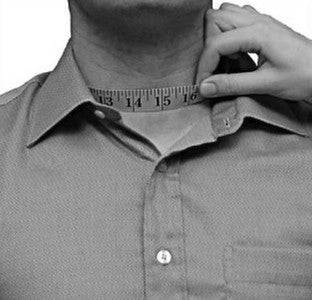
Chest*
What to Wear: Shirt (Not Jacket)
How to Measure: Measure around your chest at its widest point, roughly at the level of the nipples. Ensure the measuring tape passes underneath your armpits and over your shoulder blades at the back. Don't keep the measuring tape higher in the front or back, it must be level all the way around and should be snug, not pulling tightly, and not loose.
This measurement is a body measurement and there will be an allowance added to it to make your jacket, the allowance will be added according to the fit that you chose.
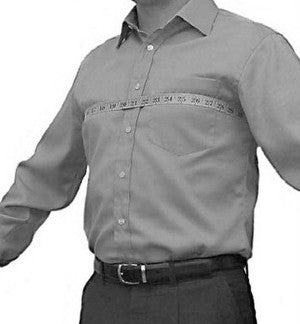
Jacket Waist*
What to Wear: Shirt (Not Jacket)
How to Measure:Measure around your waist roughly at the level of your navel or right below your bottom ribs, whichever is larger. As a guide this measurement should be where you are widest. Don't keep the measuring tape to be higher in the front or back, it must be level all the way around and don't breathe in!
This measurement is a body measurement and there will be an allowance added to it to make your jacket, the allowance will be added according to the fit that you chose.
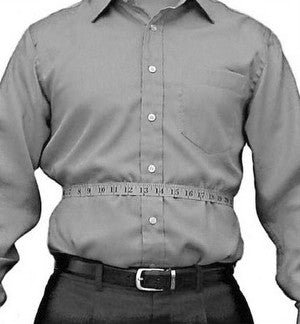
Seat*
What to Wear: Trousers (Not Jeans)
How to Measure: Measure around your hips and buttocks at their widest point. Make sure you don't have anything in your pockets; otherwise you may get a measurement which is too large.
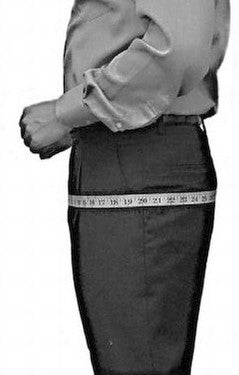
Jacket Length*
What to Wear: Shirt (Not Jacket)
How to Measure:Measure vertically down your front, from next to the collar on your shirt, where the seam is on your shoulder, to the point level with your thumb knuckle (adopt an upright position with both arms on your sides). Should you require a longer/shorter jacket please measure accordingly.
You can also use a jacket you like as a guide.
This measurement helps us determine your jacket length, but is not the only factor we consider. We also look at your height, and the type of jacket we are tailoring for you.
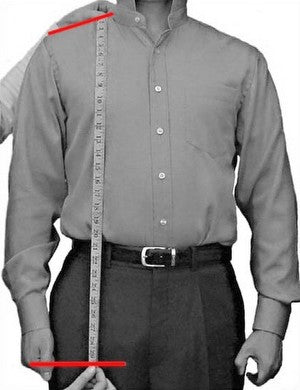
Shoulder Width*
What to Wear: Shirt
How to Measure:1) Stand from the back and visualise where the end of the shoulder is.
How to Measure:1) Stand from the back and visualise where the end of the shoulder is.
3) Measure from the left end of the shoulder to the right end of the shoulder.
4) Ensure you take the curved contour over the top of the shoulders as shown.
This is the measurement we see taken wrong most often – to check this measurement wear your best fitting jacket and take this measurement again (from shoulder end to shoulder end)– now look at both - your jacket measurement should be the same to ½ inch larger. If it’s not ask yourself is this jacket too large or too small, and from this you can now more accurately determine your shoulder size.
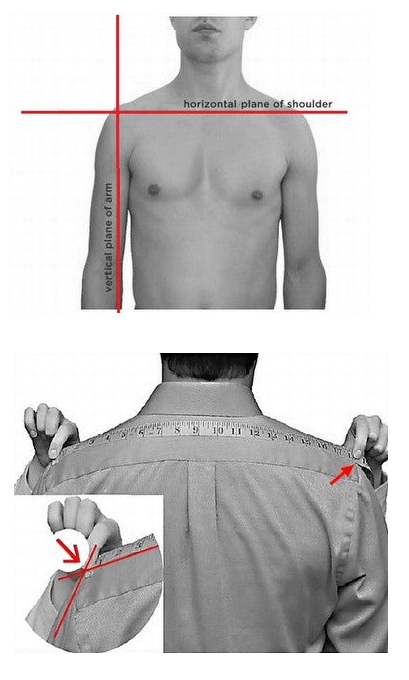
Sleeve Length*
What to Wear: Shirt
How to Measure:The sleeve measurement should be taken from exactly the same point you used earlier for the "Shoulder" measurement. (Tip: Place a safety pin where you determined the shoulder points to be on measurement above) Do NOT bend your arm and measure to a point at the wrist where you want the sleeve to end. Sleeve length is a personal choice, though recommended to end at the wrist joint so that shirt cuffs can show.
If you are unsure, take the measurement from an existing suit jacket. Take the measurement from the tip of the sleeve to the cuff edge.
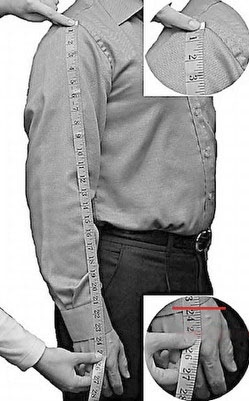
Bicep*
What to Wear: Shirt
How to Measure:Measure around the fullest part of the bicep with the arms by your side. Please note there is no need to flex, unless you are a body builder.
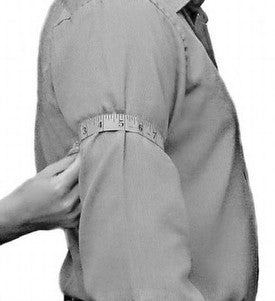
Wrist*
What to Wear: Shirt
How to Measure: Measure around the fullest part of the wrist.
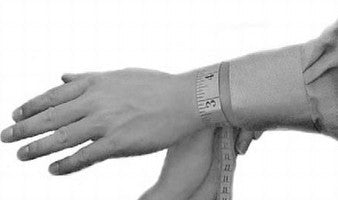
Trousers Fit*
Well Done! That’s The Jacket Finished, Now Onto The Trousers.
In order to get the type of fit that you like, we would ask you to indicate your preferred fit style below. Our tailors would then add the appropriate allowances to improve the fit of the finished trousers.
Classic fit trousers typically sits at your natural waist. It is eased through the seat, hips and thigh giving it about 1 1/2-inch more room than the Straight Fit. The slightly tapered leg is finished with a 18-19-inch leg opening.
Straight cut trousers typically sit at your natural waist and are slim through the seat and thighs, a fit that is not too loose, not too tight and finished with a leg opening of 17-18-inches.
Slim fit trousers typically sits slightly below the waist and has a short rise. It cut slim through the seat, thigh, and leg shape to fit close to the body. This very modern fit is finished off with a leg opening of 15-16-inches.
Bootcut trousers often sit at your natural waist or just below it. From the knee to the ankle, these trousers become slightly wider or “flare” out and finished with a leg opening of 19-20-inches.
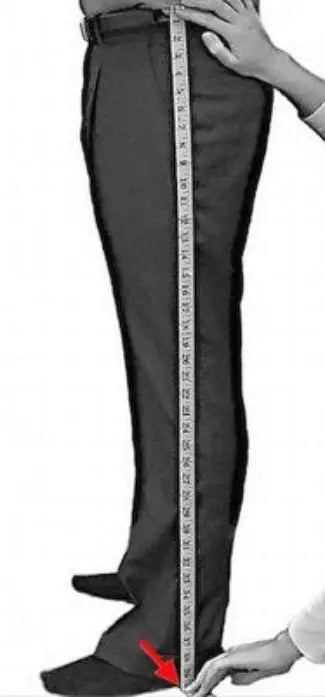
Trousers Waist *
What to Wear: Trousers (Not Jeans)
How to Measure: Lower the trousers down 1 inch without unfastening them. Measure all the way around your waistline. Make sure the tape measure stays horizontal and the measuring tape does not ride over the trousers waistband, as this will result in too large a measurement.
As a guide, this measurement will be about 2 inches above what you take off-the-rack...they like to flatter, and unfortunately we need real measurements.
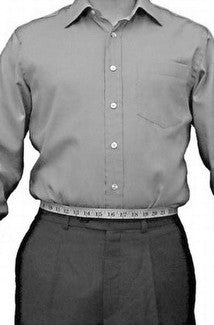
Trouser Length*
What to Wear: Trousers (Not Jeans)
How to Measure: Measure from the top of the waistband on a pair of well fitting trousers, along side of the body, to where you wish the bottom of the trousers lie. This length should allow the bottom of the trousers to rest on the shoe without touching the floor. Make sure the tape is tight, that you are standing straight, and then measure.
Alternatively, if you already have a pair of well-fitting trousers, you can provide the outside leg measurement of those.
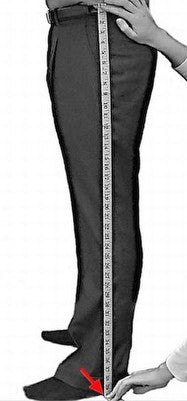
Thigh*
What to Wear: Trousers (Not Jeans)
How to Measure:Measure around your thigh at the widest point possible, which should be a couple of inches below the crotch. Make sure you don't have anything large in your pockets which might effect the measurement.
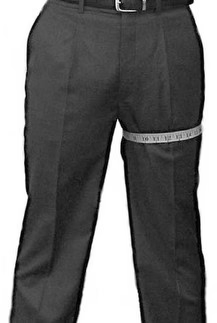
Knee*
What to Wear: Trousers
How to Measure:Measure around your knee at its widest point. Make sure your leg is straight to avoid distorting the measurement.
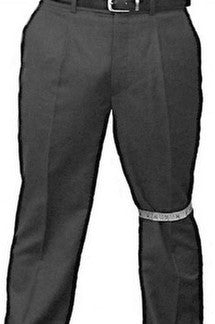
U-Crotch*
What to Wear: Trousers
How to Measure:Measure from the top of the trouser waistband at the front, between your legs, to top of the waistband at the back. Make sure not to take this measurement too tight.
The key here is to wear a comfortable pair of trousers – NO jeans!
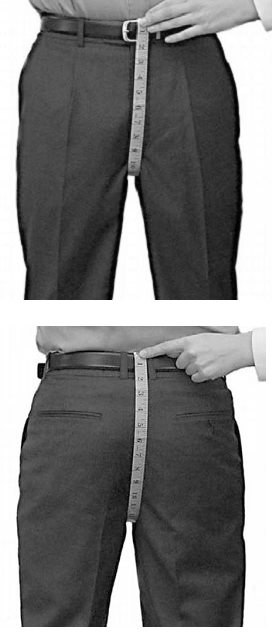
Bottom*
What to Wear: Trousers (Not Jeans)
How to Measure: Measure from one side to the other side. Be sure to pull any folds or looseness from both front and back.
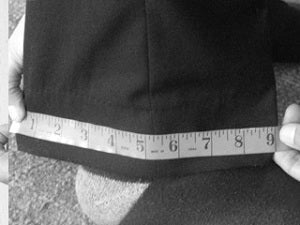
Waistcoat Length*
What to Wear: Shirt
How to Measure: Measure from next to the collar on your shirt, where the seam is on your shoulder, runs the tape in a straight line down the front to the bottom of your trousers waistband. Add about 3 inches or 7 centimeters in this measurement.
The measurement you enter here will be the front length of your finished waistcoat.
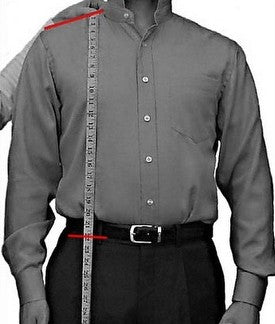
To help us produce the perfect fit for you, some additional information regarding your physique is required.
